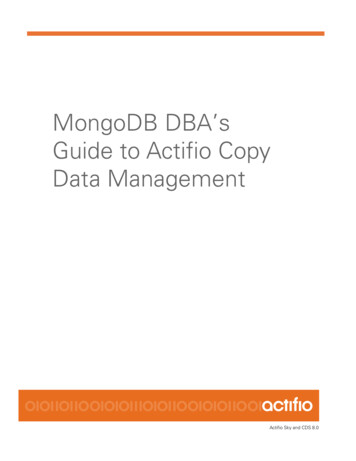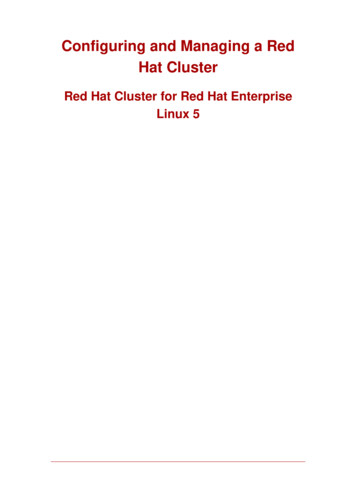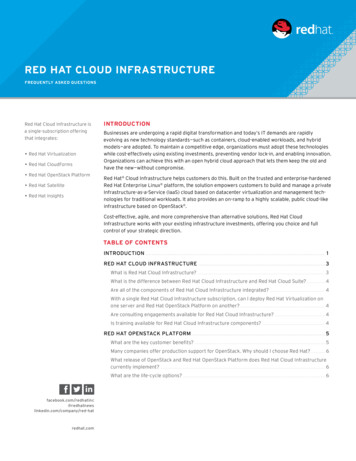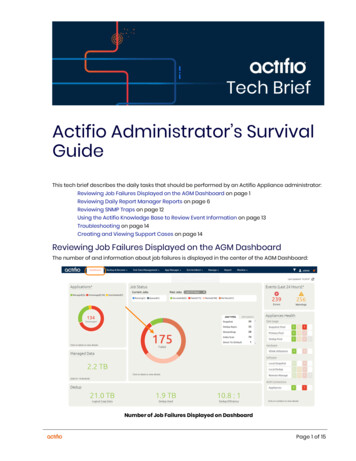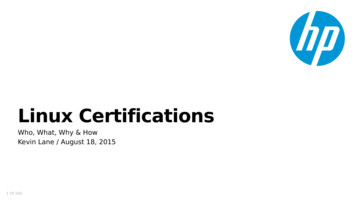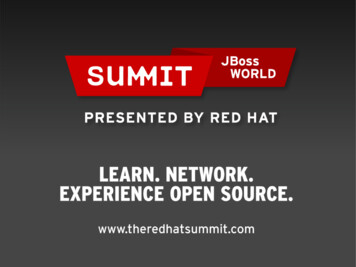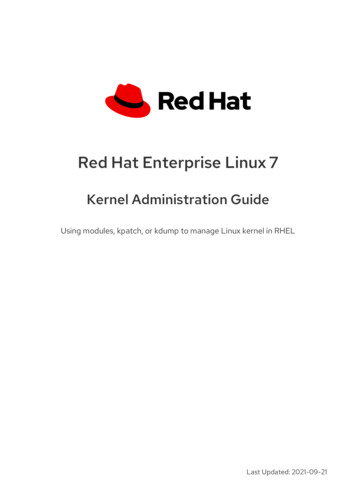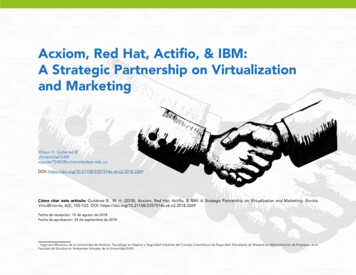
Transcription
Acxiom, Red Hat, Actifio, & IBM:A Strategic Partnership on Virtualizationand MarketingWilson H. Gutiérrez B1Universidad EANwgutier75482@universidadean.edu.coDOI: ómo citar este artículo: Gutiérrez B., W. H. (2018). Acxiom, Red Hat, Actifio, & IBM: A Strategic Partnership on Virtualization and Marketing. RevistaVirtu@lmente, 6(2), 105-122. DOI: echa de recepción: 10 de agosto de 2018Fecha de aprobación: 24 de septiembre de 2018Ingeniero Mecánico de la Universidad de América. Tecnólogo en Higiene y Seguridad Industrial del Consejo Colombiano de Seguridad. Estudiante de Maestría en Administración de Empresas de laFacultad de Estudios en Ambientes Virtuales de la Universidad EAN.1
Acxiom, Red Hat, Actifio, & IBM: A Strategic Partnership onVirtualization and Marketing. Pp. 105 - 122ABSTRACTThis document contains an analysis of strategic alliances between «big» players in informationtechnology (IT) and software applications in server virtualization (SV) and marketing alliances.The main objective is to analyze the commercial advantages, benefits, and challenges ofbusiness partners, using the SV for information management, data storage, and collaborationin marketing programs. We analyze cases of alliances in companies like IBM, Acxiom, RedHat, and Actifio, who have identified the competitive advantages of having a main «partner»,which has the ideal product or service to complement one or several secondary brands as acommercial strategy and brand positioning.The SV brings positive transformations such as the reduction of hardware costs, theimprovement of the provisioning and implementation of the server, disaster recovery solutions,efficient and economical use of energy, and increased productivity. This strategy invites tochange the way in which data centers are being formed, and becomes a preferred solutionnot only for the reduction of IT costs, but at the same time it makes a company more flexible,productive, and efficient, generating better results.The ability to capture and store more and more detailed information about customerneeds and behavior, taking advantage of the technology and intelligence of business partners,creates better opportunities in services, products, and more effective marketing campaigns,attracting new customers and positioning brands.Keywords: strategic partnership; virtualization; marketing; strategic alliances; informationtechnology (IT); service virtualization (SV); brand positioning.Revista Virtu@lmente Vol 6 Núm 2 de 2018.106
Wilson H. Gutiérrez B.Acxiom, Red Hat, Actifio e IBM: una asociaciónestratégica sobre virtualización y marketingRESUMENEste documento contiene un análisis de alianzas estratégicas entre «grandes» jugadores entecnología de la información (IT) y aplicaciones de software en la virtualización de servidores(SV) y alianzas en mercadeo. El objetivo principal es analizar ventajas comerciales, beneficiosy desafíos de socios comerciales, aprovechando la SV para la administración de información,almacenamiento de datos, y colaboración en programas de mercadeo. Se analizan casosde alianzas de compañías como IBM, Acxiom, Red Hat y Actifio, quienes han identificadolas ventajas competitivas de tener un «socio» principal, el cual tiene el producto o servicioideal, para complementar una o varias marcas secundarias, como estrategia comercial y deposicionamiento de marca.La SV trae transformaciones positivas como la reducción de costos de hardware, lamejora del aprovisionamiento e implementación del servidor, soluciones de recuperación dedesastres, uso eficiente y económico de energía, y aumento de productividad. Esta estrategiainvita a cambiar la forma en que se están formando los centros de datos y se convierte en unasolución preferida, no solo para la reducción de costos de IT, sino al mismo tiempo hace queuna empresa sea más flexible, productiva y eficiente, generando mejores resultados.La capacidad de capturar y almacenar información cada vez más detallada sobrenecesidades y comportamientos de clientes, aprovechando la tecnología e inteligencia desocios comerciales, crea mejores oportunidades en servicios, productos y campañas demercadeo más efectivas, atrayendo nuevos clientes y posicionando las marcas.Palabras clave: asociación estratégica; virtualización; marketing; alianzas estratégicas; tecnologías de la información; virtualización de servicios; posicionamiento de marca.107Universidad EAN
Acxiom, Red Hat, Actifio, & IBM: A Strategic Partnership onVirtualization and Marketing. Pp. 105 - 122Acxiom, Red Hat, Actifio et IBM: un partenariatstratégique sur la virtualisation et le marketingRÉSUMÉCe document offre une analyse des alliances stratégiques entre « grands acteurs » du secteurdes technologies de l’information (TI) et des applications logicielles pour la virtualisationde serveurs (VS) et les alliances marketing. Cet article analysera les avantages et les défiscommerciaux dont les partenaires peuvent tirer parti au niveau de la VS pour la gestion desinformations, le stockage de donnée et la collaboration sur les programmes marketing. Nousétudierons l’alliance des entreprises IBM, Acxiom, Red Hat et Actifio qui ont identifié lesavantages concurrentiels offerts par un partenaire principal proposant le produit ou le serviceidéal - stratégie, positionnement commercial, marketing - en complément d'une ou plusieursmarques secondaires.La VS engendre des transformations positives pour les entreprises comme la réductiondes coûts informatiques, une amélioration des approvisionnements et du fonctionnementdu serveur, l'utilisation plus efficiente de l'énergie et une meilleure productivité. Cettestratégie invite à changer la conception des serveurs informatiques pour en réduire les coûtsde fonctionnement et devient une solution privilégiée pour la flexibilité, la productivité etl’efficacité des entreprises qui améliorent ainsi leurs résultats opérationnels.L’obtention et le stockage de toujours plus d'informations détaillées des besoins et ducomportement des clients via la technologie et le savoir-faire stratégique des partenairescréent des opportunités commerciales et de marketing plus efficace, attirant de nouveauxclients et facilitant le positionnement des marques.Mots clefs: algèbre; intelligence artificielle (IA); réseau de neurones artificiels (ARN); systèmede tuteur intelligent (STI); gamification.Revista Virtu@lmente Vol 6 Núm 2 de 2018.108
Wilson H. Gutiérrez B.Acxiom, Rede Hat, Actifio e IBM: uma associaçãoestratégica sobre virtualização e marketingRESUMOEste documento contém uma análise da parcerias estratégicas entre «grandes» agentes emtecnologia da informação (IT) e aplicativos de software na virtualização de servidores (SV)e parcerias em marketing. O objetivo principal é analisar vantagens comerciais, benefíciose desafios de sócios comerciais, aproveitando a SV para a administração de informação,armazenamento de dados, e colaboração em programas de marketing. Analisam-se casos deparcerias de companhias como IBM, Acxiom, Rede Hat e Actifio, que reconhecem as vantagenscompetitivas de ter um «sócio» principal, com produto ou serviço ideais para complementaruma ou várias marcas secundárias, como estratégia comercial e de posicionamento de marca.A SV traz transformações positivas como a redução de custos de hardware, a melhorado fornecimento e implementação do servidor, soluções de recuperação de desastres, usoeficiente e econômico de energia e aumento de produtividade. Esta estratégia convidaa mudar a forma em que se estão formando os centros de dados e se torna uma soluçãopreferida, não só para a redução de custos de IT, mas ao mesmo tempo faz com que umaempresa seja mais flexível, produtiva e eficiente, gerando melhores resultados.A capacidade de capturar e armazenar informação cada vez mais detalhada sobrenecessidades e comportamentos de clientes, aproveitando a tecnologia e inteligência desócios comerciais, cria melhores oportunidades em serviços, produtos e campanhas demarketing mais efetivas, atraindo novos clientes e posicionando as marcas.Palavras-chave: associação estratégica; virtualização; marketing; parcerias estratégicas;tecnologias da informação; virtualização de serviços; posicionamento de marca.109Universidad EAN
Acxiom, Red Hat, Actifio, & IBM: A Strategic Partnership onVirtualization and Marketing. Pp. 105 - 1221. IntroductionThe rapid progress of globalization in the overall technology,economy, and society has strongly affected the organizationalenvironment. The reaction plans and new strategies of companies have been important in the response to these environmental changes. Companies have traditionally sought toutilize a generic competitive advantage strategy at the singlebusiness sector level. The utility of this strategy of cost advantage, differentiation, and centralization has significantly declined in the new global business environment. Accordingly,companies have actively begun to use a new strategy knownas strategic alliances between firms to respond to these limitations (Kim, 2015).There is also a description of the strategic alliances between a common partner, IBM, and the technology companies in order to develop their strategies on information management, data storage, server virtualization, and optimization;in the same way, the collaboration on marketing programswith the objective to meet their business goals and promote their brands, where a primary brand has the ideal productor service to compliment a secondary brand, utilizing targetaudiences to improve their value proposition to customersapproaching the marketing of 2020 (Cristal, 2017).2. Partnership ContextualizationThis document contains a concise analysis of the strategicalliances between «big» players in information technology (IT)and software application on server’s virtualization and partnership marketing. The main objective is to analyze the businessadvantages, remarks, benefits, and challenges of these companies, such as their strategic business partners, making thedecision of taking advantage of the server virtualization andsmart collaboration. There is an explanation of the context ofpartnership between the companies and IBM; a conceptualization of the server s virtualization and its ratio, understandingthe differences and getting a bigger picture of the technologymanagement application for data centers, and its influence onpartnership marketing.Revista Virtu@lmente Vol 6 Núm 2 de 2018.Acxiom is a consumer data, analytics, software, and marketing firm, which sells consumer data to firms seeking to improve their understanding of consumers. It is one of the largest repositories of consumer behavioral data in the world,collecting information on individual purchase and behaviorpatterns, both in off-line retail stores and online stores, enabling people-based marketing everywhere through a simple,open approach to connecting systems and data that drivesseamless customer experiences and higher Return On Investment (ROI) (Acxiom, 2018). It also offers its clients one of themost sophisticated marketing analytics capability in the marketplace.110
Wilson H. Gutiérrez B.Acxiom searched for a strategic business partner on virtualization, and turned to IBM2’s virtualization platform to achieve a more sophisticated tracking of consumers, cost savings,and greater reliability. Acxiom was facing the challenge ofmanaging around 12 petabytes3 of costumer data that wasdriven by collecting information on over 500 million consumers worldwide who together generate over 2.5 trillion consumer transactions per month, storing over 1500 data pointsfor each consumer (IBM, 2018c). Acxiom's own data centerswere handling huge increases in the volume of data; of courseand directly proportional, the costs of data centers and management were growing fast, and Acxiom was facing the demand of costumers. So, Acxiom turned to IBM s virtualizationplatform, installing over 23,000 servers. The concept of servervirtualization is widely applied in IT infrastructure as a way ofminimizing costs by increasing the utilization of the existingresources (Techopedia, 2018a).every aspect related to owning, operating, and maintaininga storage system, including backup and restore, acquisition,environmental, administration, and downtime cost factors.More than two decades ago, Red Hat had a spark of anidea, a vision for developing software in a different manner.They believed that collaboration with an ecosystem of IT leaders, such as IBM, open source advocates, developers, andpartners could create a better foundation for the future of IT.Today, they deliver a comprehensive portfolio of productsand services using the same open, collaborative business model and an affordable, predictable subscription, like Red Hat Enterprise Linux (Redhat, 2018).IBM and Red Hat announced a «strategic collaboration designed to help enterprises benefit from the speed and economics of the OpenStack4 platform, while extending their existing Red Hat virtualized and cloud workloads more easily tothe IBM Private Cloud.» As part of the agreement, IBM hasbecome a Red Hat Certified Cloud and Service Provider. IBMand Red Hat plan to jointly market and sell the new offeringsfor private cloud deployments, including workload migrations,disaster recovery, capacity expansion, and data center consolidation (Kusnetzky, 2017). It may help to provide a stimulus tothe adoption of virtualization in heterogeneous environments,addressing the interoperability challenge and limitations ofproprietary management tools.IBM offers IBM XIV Storage Systems such as the nextgeneration high-end open disk storage system. An integralpart of IBM's broad spectrum of system storage offerings,the XIV system has an innovative grid architecture designedto deliver the highest levels of reliability, performance,scalability, and functionality at low overall cost, whileeliminating complexity and providing unprecedented easeof management. Designed at an exceptionally low totalcost of ownership, the XIV system aims to tackle almostIBM (1911) Began as the Computing-Tabulating-Recording Company (CTR) and was renamed «International Business Machines» in 1924. IBM manufactures and markets computer hardware, middleware,and software, and provides hosting and consulting services in areas ranging from mainframe computers to nanotechnology (IBM, 2018).A petabyte is 1015 or 1,000,000,000,000,000 bytes. One petabyte (abbreviated "PB") is equal to 1,000 terabytes (Techterms, 2018).4OpenStack is a set of software tools for building and managing cloud computing platforms. OpenStack is managed by the OpenStack Foundation, a non-profit that oversees both development andcommunity-building around the project (Opensource, 2018).23111Universidad EAN
Acxiom, Red Hat, Actifio, & IBM: A Strategic Partnership onVirtualization and Marketing. Pp. 105 - 122According to research firm International Data Corporation(IDC)5, Windows and Red Hat Enterprise Linux are two of themain operating environments deployed by enterprises, accounting for 80% of the x86 operating systems running onhypervisors. Agreements between the two leaders indicatethat each company will join the other's virtualization validation/certification program and will provide coordinated technical support for their mutual server virtualization customers.The reciprocal validations will allow customers to deploy heterogeneous, virtualized Red Hat and Microsoft solutions withconfidence (Ng & Leong, 2009). Learning where and when the partners or alliance members plan to work together and where they are likely tocompete. If the areas of competition are broad and thearea of cooperation small, the end of the partnership oralliance is clearly in sight at the beginning. In this case,IBM and Red Hat appear to have a broad collaborationin several areas; that bodes well for this agreement. Learning how the suppliers are planning to help yourorganization get from where it is today to its futurepromised land. Hand-waving and slide presentationsare not going to get the job done. In this case, IBMhas a substantial investment in cloud operations andconsulting services designed to help its customersadopt this approach to computing. Red Hat hasinvested a great deal in its Red Hat Enterprise Linux andOpenStack offerings. It appears that both are trying tohelp customers get from where they are today to thevendors' view of the promised land. Learning how much it will cost to go on the proposedjourney. It may quickly become apparent that this isan unnecessary journey for your organization. This isthe place where decision-makers should listen verycarefully to what these suppliers are saying, match it tothe IT goals of their own enterprise and learn whetherthey are going where the enterprise wants to go.Daniel Kusnetzky, a reformed software engineer and product manager, founder of Kusnetzky Group LLC, describesthat announcements of partnerships and alliances have somestrategic promises between companies in pursue of gettingbetter results and impacting the market value and customerperceptions, described as follow: Discovering the goals of each of the players. If thegoals appear congruent, the partnership or alliance islikely to hold for a reasonable period of time. If not,it is probably just a marriage of convenience and notlikely to survive after the short-term goals have beenachieved. In this case, IBM and Red Hat both want tosee their customers use OpenStack for their on- andoff-premises cloud operations.International Data Corporation (IDC). Premier global provider of market intelligence, advisory services, and events for the information technology, telecommunications, and consumer technologymarkets.5Revista Virtu@lmente Vol 6 Núm 2 de 2018.112
Wilson H. Gutiérrez B. Learning about their plans for ongoing support forboth today's products and future products of the partnership or alliance. The history of the IT industry is littered with empty promises that led nowhere but endedup costing enterprises both time and money. How well funded is the partnership or alliance? If theonly thing behind the public effort is a press release,it can safely be ignored. In this case, both suppliershave invested heavily in their portion of the agreement(Kusnetzky, 2017).present distributed —cloud— environment. IBM’s SCDV usesActifio’s «Virtual Data Pipeline Technology», a distributedobject file system that allows the applications to access copydata directly through Actifio Copy Data Storage. Consideringthat the tremendous amount of replication that happens whileusing the data in various departments of an organizationlike development, testing, and analysis, maintaining asingle location of database is better. A minimum amount ofvirtualized data on a required basis greatly eases the burdenof swelling costs that a company dreads. Besides, it offersother benefits such as faster recovery time and enhancedease of use (Cioreview, 2014).Lets talk about other clear example of partnership marketing: IBM Launched SmartCloud Data Virtualization (SCDV)6in partnership with Actifio. It helps over 2700 global enterprise customers and service provider partners in more than 37countries around the world to virtualize their data, just as theyvirtualized their applications and infrastructure (Actifio, 2018).Actifio has been a partner of IBM for a decent amount of timeand this deal has further strengthened the relationship. It hasmade a significant contribution to growth in the IT industryowing to its remarkable product that has been widely accepted as an efficient tool to tackle the spiraling expenditure ondata storage management and services.3. Server VirtualizationLet us talk about server virtualization in order to have acontextualization of the technology solutions partnershipthat exists between the subject companies and IBM. Asdescribed on «What is Server Virtualization» video (McAllister,2007), typical enterprise data centers contain a huge numberof servers. Many of these servers sit idle as the workload isdistributed to only some of the servers on the network. Thisresults in a waste of expensive hardware resources, power,maintenance, and cooling requirements. Server virtualizationattempts to increase resource utilization by partitioningphysical servers into several multiple virtual servers, eachThis launch is a new addition to its pool of cloud softwareand services. The Database Virtualization service is a solutionthat helps in significantly reducing the number of duplicatecopies of a single data that commonly proliferate in theSmartCloud Data Virtualization (SCDV) is the latest service offering in the IBM SmartCloud Resilience portfolio. This offering leverages an appliance which uses snapshot and deduplication technologyto help save costs on replicated disk storage in a Disaster Recovery environment (IBM, 2018).6113Universidad EAN
H2PerceptionEcologicalEnvironmental Attitudes and KnEcologicalConcern (EC)Green purchasingbehavior (GPB)Acxiom, Red Hat, Actifio, & IBM: A StrategicPartnership onKnowledge (EK)Virtualization and Marketing. Pp. 105 - 122EcologicalKnowledge (EK)Affectphysical server resourcesEcologicalto(EA)virtualserver needs(Strickland,Dependent variableIndependent variable2018). Figure 1 describes the three types of virtualizationtechnology.running its own operating system and applications. Servervirtualization makes each virtual server look and act likea physical server, multiplying the capacity of every singlephysical machine (Techopedia, 2018a).Figure 1. The three types of server virtualizationsServer virtualization is a virtualization technique thatinvolves partitioning a physical server into a number of smallvirtual servers with the help of virtualization software. IBMdescribes its benefits, as follows: Gains the highest levels of isolation and data integritywith the world’s most reliable and secure servers. Reduces the cost of managing a proliferation of serverswith industry-leading cloud and IT optimization. Hypervisor Type 1Virtual MachineMonitor (VMM) orHardware EmulationHypervisor Type 2VirtualizationParavitualizationOS VirtualizationEases administration processes with our tools toconsolidate and deploy a wide range of workloadtypes.Source. Prepared by the author based on the Securitywing model, 2014.3.1 Understanding the differencesServer virtualization allows organizations to optimizetheir IT infrastructure and save money. Virtualizationon IBM Z and IBM LinuxONE allows you to inheritthe unique advantages of IBM z/Architecture (IBM,2018b).One of the methods of server virtualization is the Hypervisor,Hardware Emulation (Securitywing, 2014), or Virtual MachineMonitor (VMM); which is a computing layer that allows multipleoperating systems to run on a host computer at the sametime. The VMM is the primary software behind virtualizationenvironments and implementations; when installed on a hostmachine, the VMM facilitates the creation of VMs, each withseparate operating systems (OS) and applications. The VMMmanages the backend operation of these VMs by allocatingthe necessary computing, memory, storage, and other input/output (I/O) resources. The VMM also provides a centralizedinterface for managing the entire operation, status, andThere are three ways to create virtual servers: fullvirtualization, para-virtualization, and OS-level virtualization(McAllister, 2007). They all share a few common traits. Thephysical server is called the host and the virtual serversare called guests. The virtual servers behave like physicalmachines; each system uses a different approach to allocateRevista Virtu@lmente Vol 6 Núm 2 de 2018.H3oneptiPerc114
Wilson H. Gutiérrez B.availability of the VMs that are installed on a single host orspread across different and interconnected hosts (Techopedia,2018a).Paravirtualization technology was introduced by IBMand was developed as an open-source software project(Techopedia, 2018d).Paravirtualization is other type of virtualization techniquethat provides an interface to virtual machines that are similarto their underlying hardware. In paravirtualization, the guestoperating system is explicitly ported before installing a virtualmachine because a non-tailored guest operating systemcannot run on top of a virtual machine monitor (VMM).Paravirtualization enables several different operating systemsto run on one set of hardware by effectively using resourcessuch as processors and memory. In paravirtualization, theoperating system is modified to work with a virtual machine.The intention behind the modification of the operating systemis to minimize the execution time required in performingthe operations that are otherwise difficult to run in a virtualenvironment.Then, operating system virtualization —OS virtualization—involves tailoring a standard operating system so that itcan run different applications handled by multiple userson a single computer at a time. The operating systems donot interfere with each other although being on the samecomputer. In OS virtualization, the operating system is alteredso that it operates like several different, individual systems.The virtualized environment accepts commands from differentusers running different applications on the same machine.The users and their requests are handled separately by thevirtualized operating system. Also known as operating systemlevel virtualization.Operating system virtualization provides to lingapplications from the OS. The OS virtualization techniqueoffers granular control at the application level by facilitatingthe transparent migration of individual applications. Thefiner granularity migration offers greater flexibility, resultingin reduced overhead. The OS virtualization can also be usedto migrate critical applications to another running operatingsystem instance. Patches and updates to the underlyingoperating system are done in a timely way and have littleor no impact on the availability of application services. Theprocesses in the OS virtualized environment are isolatedand their interactions with the underlying OS instance aremonitored (Techopedia, 2018 e).Paravirtualization has many significant performanceadvantages and its efficiencies offer better scaling. As a result,it is used in various areas of technology, such as: Partitioning development environments from testingsystems. Disaster recovery. Migrating data from one system to another. Capacity management.115Universidad EAN
Acxiom, Red Hat, Actifio, & IBM: A Strategic Partnership onVirtualization and Marketing. Pp. 105 - 122A summary of remarks and disadvantages of the types of virtualization are described in table 1.Table 1. Remarks and disadvantages of the virtualizationVirtualization TypeRemarksDisadvantagesVirtual Machine Monitor (VMM) or HardwareemulationThe hypervisor monitors the physical resources ofthe server. As virtual servers run applications, thehypervisor relays resources from the physical machineto the appropriate virtual server. Hypervisors havetheir own processing needs, which means that thephysical server must reserve some processing powerand resources to run the hypervisor application. Thiscan impact the overall performance of the server andslow down applications.It Gives an abstract view of underlyinghardware, offering support for heterogeneousOS. This is a market leading virtualizationtechnology.There is no need to modify the OS andapplications in order to run on the virtualenvironment.Products: VMware, VMserver, VMware ESX,Microsoft virtual server.Disadvantages of type 2: they have more points offailure since anything affecting the stability of thebase operating system can also affect the guest OSand the virtual machine. When the base OS needs areboot, all the VM will also be rebooted.ParavirtualizationThe paravirtualization approach is a little different.Unlike the full virtualization technique, the guestservers in a paravirtualization system are aware ofone another. A paravirtualization hypervisor doesnot need as much processing power to manage theguest operating systems, because each OS is alreadyaware of the demands that the other operatingsystems are placing on the physical server. The entiresystem works together as a cohesive unit.It multiplexes the access to hardwareresources, offers high performance, requiresguest OS modification before deployment. Itis more complex than hardware emulation.Product: Xen (open source)The requirement of modifying the guest operatingsystem in order to execute and communicate withthe hypervisor. The kernel of the guest OS must bemodified before installation.Since modifying a kernel of proprietary OS suchas Windows is not possible, the paravirtualizationsoftware users (such as Xen users) have to use anopen source OS like Linux or OpenSolaris.Operating System (OS) VirtualizationAn OS-level virtualization approach does not use ahypervisor at all. Instead, the virtualization capabilityis part of the host OS, which performs all thefunctions of a fully virtualized hypervisor. The biggestlimitation of this approach is that all the guest serversmust run the same OS. Each virtual server remainsindependent from all the others, but you cannot mixand match operating systems among them. Giventhat all the guest operating systems must be thesame, this is called a homogeneous environment.It creates an abstract view of the OS includingthe root file system, the process table, etc.They are suitable for homogeneous OSenvironment where a consistent OS versionis necessary. Products: OpenVZ, Virtuozzo,Sun Solaris.They support only one operating system as baseand guest OS in a single server. You have to choosea single OS such as Windows or Linux. All the OSin the container should be the same version andshould have the same patch level of the base OS.If the base OS crashes, the entire virtual containerbecomes unavailable.Source. Prepared by the
to help save costs on replicated disk storage in a Disaster Recovery environment (IBM, 2018). present distributed —cloud— environment. IBM's SCDV uses Actifio's «Virtual Data Pipeline Technology», a distributed object file system that allows the applications to access copy data directly through Actifio Copy Data Storage. Considering

